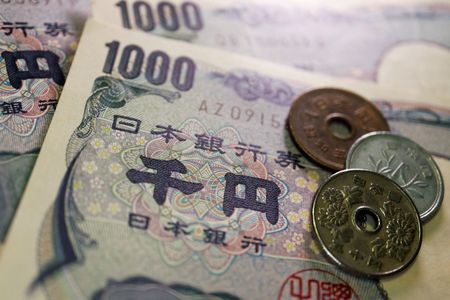
By Rae Wee
SINGAPORE (Reuters) – The dollar took a breather on Tuesday after a sweeping rally but notched a fresh 24-year high against the rate-sensitive Japanese yen, as U.S. monetary policy tightening gathers pace and widens the gap with Japan’s stubbornly low interest rates.
The yen bottomed at 140.97, the lowest since 1998, and last traded 140.91 per dollar.
“After we saw the break of 140 … the momentum definitely was skewed for yen weakness,” said Galvin Chia, an emerging markets strategist at NatWest Markets.
“So long as (yield curve control) is in play, and so long as interest rate divergence is in place, one of those side effects would be a weaker yen.”
Elsewhere, the greenback eased slightly from milestone highs on the euro and sterling, although recession fears and a gas crisis kept caps on both currencies.
The euro was up 0.36% to $0.99605 after it hit a two-decade low of $0.9876 on Monday as the prospects for a winter without Russian gas sunk in.
Russia has halted gas flow along the Nord Stream 1 pipeline to Germany indefinitely, at first blaming an oil leak at a compressor station but on Monday linking the stoppage to sanctions imposed by the west.
Gazprom’s deputy chief executive Vitaly Markelov told Reuters on Tuesday that the pipeline will not resume shipments until Siemens Energy repairs faulty equipment.
Sterling was last up 0.54% at $1.1585, after sliding to a 2-1/2-year low of $1.1444 on Monday. Liz Truss is Britain’s new prime minister after winning a leadership vote on Monday and her promises of tax cuts add uncertainty to government finances.
“Existential choices now need to be made, because there may not be enough energy to go round,” said Michael Every, global strategist at Rabobank.
“The choices are obviously unappetising.”
Meanwhile, the Aussie was little changed after the Reserve Bank of Australia raised its cash rate by 50 basis points and was last up 0.05% at $0.6801. The kiwi was similarly largely flat at $0.6096.
The RBA board signalled further rate hikes to come but noted that it is not on a pre-set path.
“In general, currency reactions to rate rises outside of the U.S. in recent months, even if they exceed expectations, don’t seem to have more than a temporary impact,” said National Australia Bank’s head of FX strategy, Ray Attrill.
Elsewhere in Asia, Chinese authorities have sought to slow the yuan’s recent depreciation and late on Monday cut the foreign exchange reserve requirement ratio (RRR), freeing up dollars for banks to sell.
The move had only a limited effect on the exchange rate, with the yuan pinned near its two-year low at 6.9510 in offshore trade.
The dollar index fell 0.02% to 109.58 after rising as high as 110.27 on Monday.
(Reporting by Rae Wee; Editing by Shri Navaratnam and Sam Holmes)

